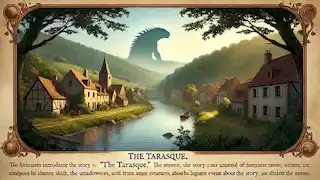Introduction
In the heart of medieval France, where history and myth intertwine, there existed a legendary beast so feared that it terrorized entire villages. This was the Tarasque—a monstrous creature described as part dragon, part serpent, and part lion, whose reign of terror is forever imprinted in the folklore of Provence. The tale of the Tarasque, passed down through generations, not only speaks of fearsome battles and heroic deeds but also serves as a symbol of humanity's capacity for transformation and redemption.
The story begins with a quiet, peaceful land that soon found itself gripped by terror. Along the banks of the River Rhône, the people of the town of Nerluc lived in constant fear of the creature that stalked their lands. With scales that could deflect any weapon, a powerful lion-like body, and a serpent’s tail lashing behind it, the Tarasque was not an ordinary dragon. It was said that no warrior could defeat it, and no town was safe from its fury. Crops were ruined, livestock was slain, and villagers disappeared without a trace. The Tarasque was a living nightmare.
But in every tale of terror, there comes hope. This hope arrived in the form of Saint Martha, a figure known for her courage and faith. She had already established her reputation as a healer and miracle worker, and when she heard of the havoc the Tarasque wreaked upon Nerluc, she knew that she must confront the beast—not with weapons, but with compassion.
This is the story of a battle fought not with sword and steel, but with heart and spirit. It is a tale of redemption, forgiveness, and transformation that has echoed through centuries, remaining a cornerstone of French folklore.
The Rise of the Tarasque
The sun had barely begun to rise over the town of Nerluc, a place nestled quietly between the River Rhône and the hills of Provence. Farmers woke before dawn, their hands rough and worn from years of tending the soil, while fishermen cast their nets into the river, hoping for a bountiful catch. Life in Nerluc was simple, and for the longest time, it was peaceful. But that peace was shattered with the arrival of a creature so terrifying that even the bravest men in the village trembled at its name: the Tarasque.
The Tarasque did not appear gradually. One morning, the village awoke to find their fields trampled, their livestock torn apart, and ominous tracks leading to the river. These were no ordinary tracks—they were enormous, the claw marks deeper than anything seen before. At first, the villagers hoped it was just a lone beast passing through, but their hopes were soon dashed. Each night, the creature returned, wreaking more havoc with every visit.
The people of Nerluc quickly realized they were dealing with something far more dangerous than a mere wild animal. The stories began to spread about the Tarasque’s true nature. Its body was that of a colossal lion, covered in thick, impenetrable scales. Its head resembled a dragon’s, complete with a maw full of razor-sharp teeth that could crush a tree trunk. Its tail, long and serpent-like, could knock down walls with a single sweep. The Tarasque was not just a beast; it was a nightmare brought to life.
Men from the village tried to fight it. Armed with swords, spears, and bows, they set out at night to hunt the creature. But none returned. The few who survived fled back to the village, their weapons shattered, and their spirits broken. The Tarasque was invulnerable to all attacks. No matter how hard they fought, nothing seemed to pierce its scaly hide. The village was trapped, living in constant fear of when the beast would strike next.
The King of Nerluc, who had remained hidden in his fortified castle on the hill, finally realized the gravity of the situation. If nothing was done, his kingdom would fall to ruin. In desperation, he sent out word to the surrounding lands, pleading for any warrior, magician, or scholar who could help defeat the Tarasque. But none came.
The people of Nerluc began to lose hope. The Tarasque was relentless, and their once-thriving village had become a wasteland. Crops withered in the fields, livestock disappeared, and no one dared venture outside after dusk. The town was suffocating under the weight of fear.
That was when a rumor reached their ears—a tale of a holy woman who had performed miracles in distant lands. Her name was Saint Martha, and she had gained a reputation for her ability to calm storms, heal the sick, and even raise the dead. Could she be the one to save Nerluc from the beast that haunted it?
Saint Martha Arrives
Saint Martha had heard of the Tarasque long before she reached Nerluc. Word of the beast’s reign of terror had traveled far and wide, spreading across Provence like wildfire. Many had sought her out for help, asking her to come and rid the land of the monster. Saint Martha, who had devoted her life to helping others, felt a pull to Nerluc. She knew that her mission was not to slay the beast but to save it, to bring peace not just to the people, but to the creature itself.
It was a difficult journey to Nerluc, with winding roads and treacherous terrain, but Saint Martha traveled undeterred, accompanied only by her faith and a small band of followers. The closer she came to the village, the more she could sense the fear and despair that had gripped the land. The fields were barren, and the air was thick with tension. Every step closer to Nerluc brought with it the scent of destruction and the palpable weight of sorrow.
When she finally reached the village, the people greeted her with a mixture of awe and disbelief. Could this quiet, humble woman truly stand a chance against the Tarasque? The villagers, worn down by months of terror, had little faith left in anything, but Saint Martha’s presence brought with it a glimmer of hope.
Saint Martha wasted no time. She asked the villagers to take her to the lair of the beast. They led her to the edge of the river, where the thick forest met the banks of the Rhône. It was here that the Tarasque had been sighted many times, lurking in the shadows, waiting to strike.
She stood before the forest, her eyes scanning the dense trees and thick underbrush. The Tarasque was there, she could feel it, watching her, waiting. But Saint Martha was not afraid. She knew that violence would not defeat the beast. She would need something far stronger—compassion.
With her heart steady and her faith strong, she stepped into the forest.
The Confrontation
The forest was eerily silent as Saint Martha walked deeper into the trees. The air was thick and oppressive, as though the very earth itself was holding its breath. Her followers, who had been walking behind her, stopped at the edge of the forest, too fearful to continue. Saint Martha did not blame them. The power of the Tarasque could be felt all around her, like a dark cloud hanging over the land.
As she ventured further, the sounds of the forest slowly returned—birds chirped, leaves rustled, and the river's current hummed in the distance. But these peaceful noises were suddenly shattered by a low, menacing growl that echoed through the trees.
Saint Martha stopped, her eyes scanning the shadows. And then she saw it.
The Tarasque emerged from the darkness, its massive form looming over the trees. It was even more terrifying than the villagers had described. Its scales glinted in the dim light, its eyes glowing with malice, and its long tail whipped through the air with a speed that belied its size. The ground trembled beneath its feet as it advanced toward her, its maw opening to reveal rows of jagged teeth.
But Saint Martha did not flee. She did not raise her arms in defense or prepare to strike. Instead, she knelt down, closed her eyes, and began to pray.
The Tarasque halted, confused by the sight before it. It had expected fear, screams, and the flash of weapons. But here was a woman, unarmed and unafraid, speaking softly in a language it did not understand.
Saint Martha’s prayer was not for the creature’s destruction but for its redemption. She called upon the forces of light and love to calm the Tarasque’s spirit, to release it from the rage that consumed it. She prayed for peace, for the creature to find its place in the world without bringing harm to others.
As she prayed, the Tarasque began to change. Its snarls softened, its posture relaxed, and the fierce glow in its eyes dimmed. It took a step back, and then another, as though it were no longer sure of the malice that had driven it for so long. The power of Saint Martha’s compassion was stronger than any sword, and the beast, for the first time, felt something it had never known before—peace.
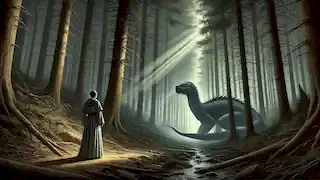
The Transformation
The transformation of the Tarasque was not instant, but it was undeniable. The once-feared creature, who had terrorized an entire region, now stood before Saint Martha, subdued and calm. Its scales no longer bristled with menace, and the fiery anger in its eyes had faded to a soft, almost questioning gaze. It was as though the creature was waking up from a long nightmare, unsure of where it was or what it had done.
Saint Martha slowly rose to her feet, her heart filled with gratitude. She approached the creature without fear, gently placing her hand on its massive head. The Tarasque flinched at first but did not pull away. Instead, it lowered its head, submitting to her touch. The moment was quiet and profound—the beast, once filled with rage and destruction, was now at peace, not just with the world, but with itself.
The people of Nerluc, who had been watching from the safety of the village, could hardly believe what they were seeing. The terrifying creature that had haunted their nightmares was now docile, standing calmly beside Saint Martha like a tamed lion. Word quickly spread through the village, and soon, the people began to gather at the edge of the forest, watching in awe as Saint Martha led the Tarasque back toward the town.
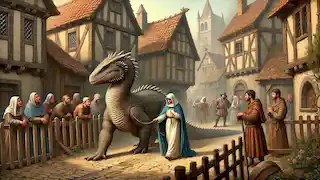
Redemption and Rebirth
The journey back to the village was slow but steady. The Tarasque followed Saint Martha willingly, like a loyal companion. The people of Nerluc, who had once feared the very mention of the creature's name, now watched in wonder as the once-mighty beast walked among them, no longer a monster but a symbol of redemption.
When they reached the village, Saint Martha addressed the people. She told them of the power of compassion, of how even the darkest, most fearsome creature could be transformed through love and understanding. The villagers listened, their hearts filled with a mixture of relief and hope. They had been saved, not by violence, but by the kindness and strength of a single woman.
The King of Nerluc, who had witnessed the events from his castle, was so moved by the miracle that he decreed the town would forever honor the memory of this event. The village of Nerluc was renamed Tarascon, in honor of the beast that had once terrorized its people but had now become a symbol of their salvation.
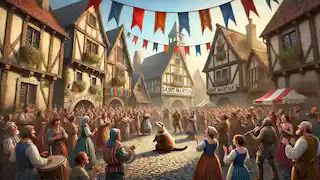
Legacy of the Tarasque
The story of the Tarasque and Saint Martha quickly spread beyond the borders of Provence, becoming one of the most beloved legends in French folklore. The people of Tarascon built a church in honor of Saint Martha, and every year, they celebrated the day when the beast was tamed, with festivals, parades, and reenactments of the fateful encounter between the saint and the creature.
Over the years, the Tarasque became more than just a legend—it became a symbol of the power of transformation, the idea that even the most fearsome creatures, whether literal or metaphorical, could be redeemed through love, understanding, and compassion. The story was passed down through generations, retold in different forms but always carrying the same message of hope and forgiveness.
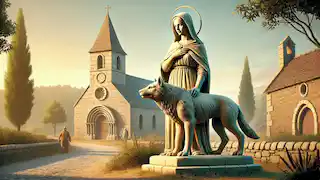
Conclusion
The legend of the Tarasque is more than just a story about a dragon-like beast that terrorized a village; it is a testament to the power of empathy and the strength of the human spirit. It reminds us that even in the darkest of times, there is always the possibility of redemption and that sometimes, the greatest battles are not won with swords, but with kindness.
